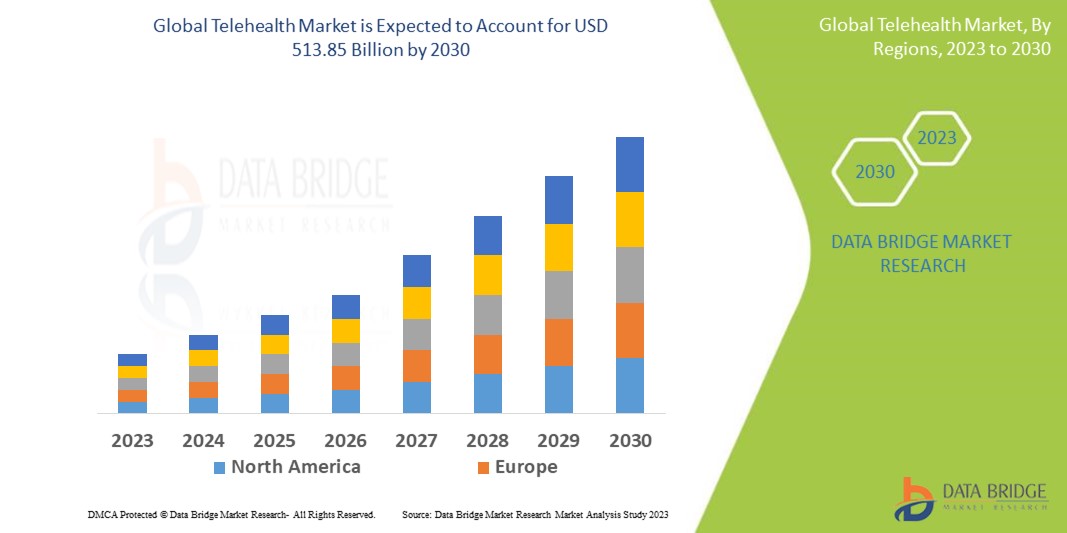Global Telehealth Market, By Type (Software, Systems, Hardware, Telecommunication) Delivery Mode (Cloud-Based Delivery Mode, Web-Based Delivery Mode, On-Premise Delivery Mode) Application (General Consultation, Pathology, Cardiology, Surgery, Gynecology, Neurology, Radiology, Dermatology, Ophthalmology, Orthopedics, Others) End User (Hospital Telehealth, Physician Telehealth, Home Telehealth) – Industry Trends and Forecast to 2030.

Telehealth Market Analysis and Size
With the increasing adoption of smartphones and the huge availability of technologically advanced devices, the market is witnessing huge growth. As per WHO, healthcare facilities are expected to witness a shortage of 15 million healthcare professionals by 2030; this is anticipated to increase the adoption of AI for the treatment and diagnosis of patients and enhance the accessibility of healthcare services in remote locations and minimize healthcare expenses. The increasing number of COVID-19 cases in Asia-Pacific increased the adoption of digital health platforms for remote healthcare services.
Data Bridge Market Research analyses a growth rate in the telehealth market in the forecast period 2023-2030. The expected CAGR of the telehealth market tends to be around 25.5% in the mentioned forecast period. The market was valued at USD 83.5 billion in 2022 and will grow to USD 513.85 billion by 2030. In addition to the market insights such as market value, growth rate, market segments, geographical coverage, market players, and market scenario, the market report curated by the Data Bridge Market Research team also includes in-depth expert analysis, patient epidemiology, pipeline analysis, pricing analysis, and regulatory framework.
Telehealth Market Scope and Segmentation
|
Report Metric |
Details |
|
Forecast Period |
2023 to 2030 |
|
Base Year |
2022 |
|
Historic Years |
2021 (Customizable to 2015 - 2020) |
|
Quantitative Units |
Revenue in USD Billion, Volumes in Units, Pricing in USD |
|
Segments Covered |
Type (Software, Systems, Hardware, Telecommunication) Delivery Mode (Cloud-Based Delivery Mode, Web-Based Delivery Mode, On-Premise Delivery Mode) Application (General Consultation, Pathology, Cardiology, Surgery, Gynecology, Neurology, Radiology, Dermatology, Ophthalmology, Orthopedics, Others) End User (Hospital Telehealth, Physician Telehealth, Home Telehealth) |
|
Countries Covered |
U.S., Canada, and Mexico in North America, Germany, France, U.K., Netherlands, Switzerland, Belgium, Russia, Italy, Spain, Turkey, Rest of Global in Global, China, Japan, India, South Korea, Singapore, Malaysia, Australia, Thailand, Indonesia, Philippines, Rest of Asia-Pacific (APAC) in the Asia-Pacific (APAC), Saudi Arabia, U.A.E, South Africa, Egypt, Israel, Rest of Middle East and Africa (MEA) as a part of Middle East and Africa (MEA), Brazil, Argentina and Rest of South America as part of South America |
|
Market Players Covered |
Teladoc Health, Inc. (U.S.), Siemens (Germany), Cisco Systems, Inc. (U.S.), Koninklijke Philips N.V. (Netherlands), IBM (U.S.), Oracle (U.S.), Medtronic (Ireland), F. Hoffmann-La Roche Ltd (Switzerland), Tunstall Group (U.K.), American Well (U.S.), CareCloud, Inc. (U.S.), eClinicalWorks (U.S.), AMD Global Telemedicine (U.S.) |
|
Market Opportunities |
|
Market Definition
Telehealth means using communication technologies and digital information to access health care services remotely and manage health care. Telehealth enables caregivers and nurses to constantly connect while providing physicians with real-time patient health information. Telehealth facilities utilize technology to deliver long-distance health education to enhance customer outcomes.
Global Telehealth Market Dynamics
Drivers
- Increase in Healthcare Digitalization Activities and Government Initiatives
Growing healthcare digitalization activities and increasing government initiatives in remote patient monitoring are expected to increase the market's growth over the upcoming years. For instance, the Indian Government launched National Telemedicine Service or eSanjeevaniOPD, which will complete about 1.2 crore teleconsultations by 2021. In addition, increasing campaigns by the Government and non-governmental organizations for the high use of telehealth and remote patient monitoring services for long-term care services is also expected to increase the global market growth. Thus, this factor increases the growth of the market.
- Growing Use of Web-and Cloud-Based Platforms
The launch of the web- and cloud-based platforms, which provide virtual care to users, are anticipated to increase the industry growth. For instance, CVS partnered with Teladoc to launch CVS Health's Aetna Virtual Primary Care in 2021. The partnership was done so that CVS Health will use Teladoc's physician network to deliver virtual care services to patients remotely through video consultations, decreasing the patient's dependency on in-person consultations and visits. Thus, this factor boosts market growth.
Opportunities
- Increasing Use of AI and ML Algorithms
The wide application of AI and ML algorithms is increasing the customization of healthcare services. For instance, Haldoc's telehealth platform, combined with AI, offers its physicians feedback from the patients on their consultations and provides training programs that help in performance improvement. Numerous insurance companies and healthcare providers have teamed up to develop new strategies to surge the adoption of telehealth services and applications. Thus, this factor boosts market growth.
- Growing Strategic Collaborations and Acquisitions by Market Players
The increasing rate of collaboration and acquisitions by major market players and the increasing number of startups in the market is expected to increase the market growth. For instance, in 2021, doctor Anywhere, a Singapore-based company, acquired one of the largest telemedicine platforms in Thailand, Doctor Raksa. This platform served over a million customers with e-prescriptions, electronic medical summaries, online doctor and pharmacist consultations, and prescription refills. Therefore, these kinds of acquisitions will surge the market growth.
Restraints/Challenges
- Behavioral Interferences Using a Remote Monitoring System
Physicians and patients often lack familiarity with several new practices and face difficulty in practicing new devices. Elderly people may also deny using telehealth and telemedicine services due to unfamiliarity with technology. Behavioral barriers impose major challenges to telehealth and telemedicine adoption. Therefore, all these factors impede the growth of the market.
This telehealth market report provides details of new recent developments, trade regulations, import-export analysis, production analysis, value chain optimization, market share, impact of domestic and localized market players, analyses opportunities in terms of emerging revenue pockets, changes in market regulations, strategic market growth analysis, market size, category market growths, application niches and dominance, product approvals, product launches, geographic expansions, technological innovations in the market. To gain more info on the telehealth market contact Data Bridge Market Research for an Analyst Brief, our team will help you take an informed market decision to achieve market growth.
Recent Development
- In 2020, Columbia Asia Hospital group launched a telehealth service that offers numerous services, including doctors through video calls, medical advice and/or clinical management, and drug prescriptions.
- In 2020, Oracle acquired Cerner Corp. with a 69.2% stake. After the acquisition, both companies will mainly focus on codeveloping advanced healthcare analytics solutions and increasing their product portfolio and business footprint.
Global Telehealth Market Scope
The telehealth market is segmented on the basis of type, delivery mode, application, and end user. The growth amongst these segments will help you analyze meagre growth segments in the industries and provide the users with a valuable market overview and market insights to help them make strategic decisions for identifying core market applications.
Type
- Software
- Systems
- Hardware
- Telecommunication
Delivery Mode
- Cloud-Based Delivery Mode
- Web-Based Delivery Mode
- On-Premise Delivery Mode
Application
- General Consultation
- Pathology
- Cardiology
- Surgery
- Gynecology
- Neurology
- Radiology
- Dermatology
- Ophthalmology
- Orthopedics
- Others
End User
- Hospital Telehealth
- Physician Telehealth
- Home Telehealth
Telehealth Market Regional Analysis/Insights
The telehealth market is analyzed and market size insights and trends are provided by type, delivery mode, application and end user as referenced above.
The major countries covered in the telehealth market report are U.S., Canada, and Mexico in North America, Germany, France, U.K., Netherlands, Switzerland, Belgium, Russia, Italy, Spain, Turkey, Rest of Global in Global, China, Japan, India, South Korea, Singapore, Malaysia, Australia, Thailand, Indonesia, Philippines, Rest of Asia-Pacific (APAC) in the Asia-Pacific (APAC), Saudi Arabia, U.A.E, South Africa, Egypt, Israel, Rest of Middle East and Africa (MEA) as a part of Middle East and Africa (MEA), Brazil, Argentina and Rest of South America as part of South America.
North America dominates the telehealth market because of increased healthcare awareness. Additionally, the growing adoption of cloud-based technologies is also increasing the market growth during the forecast period. The presence of major market players in the region and the development of startups will also lead to the adoption of telehealth platforms in the region.
Asia-Pacific is expected to have the highest growth rate in the forecast period due to the increasing elderly population and growing integration of digital healthcare facilities. Furthermore, the increase in virtual healthcare delivery platforms for electronic health records and patient therapy systems is also increasing the market growth.
The country section of the report also provides individual market impacting factors and changes in regulation in the market domestically that impacts the current and future trends of the market. Also, the presence and availability of Global brands and their challenges faced due to large or scarce competition from local and domestic brands, impact of domestic tariffs and trade routes are considered while providing forecast analysis of the country data.
Healthcare Infrastructure Growth Installed base and New Technology Penetration
The telehealth market also provides you with detailed market analysis for every country growth in healthcare expenditure for capital equipment, installed base of different kind of products for telehealth market, impact of technology using life line curves and changes in healthcare regulatory scenarios and their impact on the telehealth market. The data is available for historic period 2011-2021.
Competitive Landscape and Global Telehealth Market Share Analysis
The telehealth market competitive landscape provides details by competitor. Details included are company overview, company financials, revenue generated, market potential, investment in research and development, new market initiatives, Global presence, production sites and facilities, production capacities, company strengths and weaknesses, product launch, product width and breadth, application dominance. The above data points provided are only related to the companies' focus related to telehealth market
Key players operating in the telehealth market include:
- Teladoc Health, Inc. (U.S.)
- Siemens (Germany)
- Cisco Systems, Inc. (U.S.)
- Koninklijke Philips N.V. (Netherlands)
- IBM (U.S.)
- Oracle (U.S.)
- Medtronic (Ireland)
- F. Hoffmann-La Roche Ltd (Switzerland)
- Tunstall Group (United Kingdom)
- American Well (U.S.)
- CareCloud, Inc. (U.S.)
- eClinicalWorks (U.S.)
- AMD Global Telemedicine (U.S.)
SKU-





 Forecast Period
Forecast Period  Market Size (Base Year)
Market Size (Base Year)  Market Size (Forecast Year)
Market Size (Forecast Year) CAGR
CAGR










